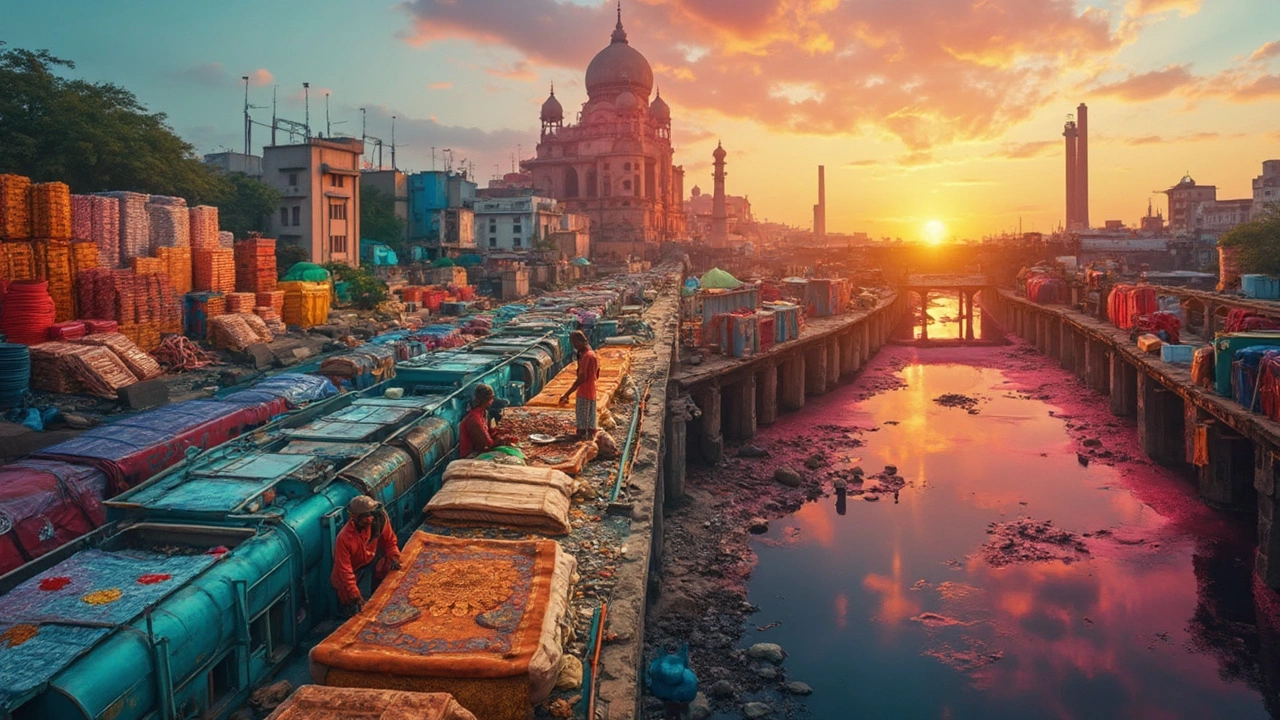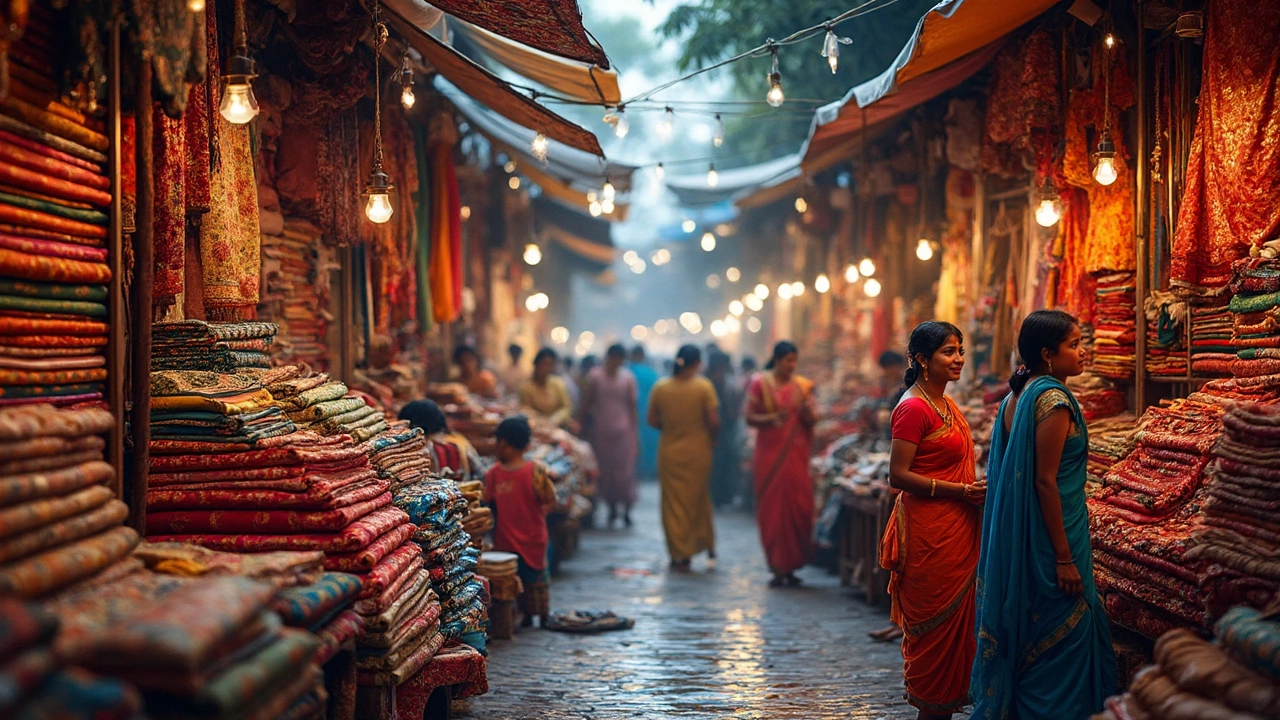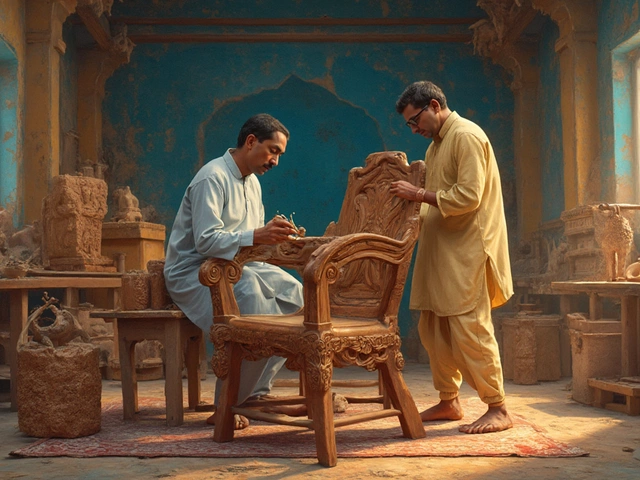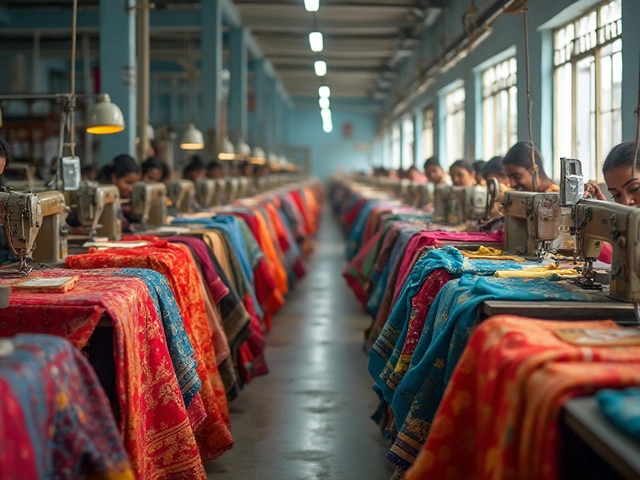Ever heard people talk about “Surat fabric” and wondered what makes it so special? This city in Gujarat isn’t just another dot on the map; it’s the place where half the saris and a big chunk of synthetic clothes found all over India actually get made. Walk down any big cloth market in the country—there’s a huge chance what you're seeing has its roots in Surat.
The numbers are wild. Surat produces around 30 million meters of fabric every single day. Yep, you read that right—every day! Locals joke that even at midnight, you can hear the hum of weaving machines somewhere in the city. That’s because the textile business here never really sleeps.
If you or someone you know has ever worn a shiny polyester sari, a light chiffon dupatta, or even a trendy dress material bought online, chances are high it passed through Surat’s hands. You could call Surat the “backstage” of fashion that keeps everyone dressed up, whether it’s for everyday wear or for fancy weddings. But how did Surat get so big in this game, and why do textile experts swear by it? Let’s pull back the curtain and get into the untold story of Surat’s clothing fame.
- How Surat Became India’s Textile Powerhouse
- Fabrics and Clothing Surat Is Famous For
- The Heartbeat: Surat's Textile Markets
- Why Manufacturers and Buyers Love Surat
- Tips for Visiting Surat’s Textile Scene
How Surat Became India’s Textile Powerhouse
Surat wasn’t always the king of clothes. Back in the 1960s, the city mostly dealt in diamond polishing and trading. But as more people started moving in searching for work, some sharp business minds realized the city’s location was a big win. They set up weaving units, taking advantage of the easy routes to Mumbai’s ports and raw materials flowing in from the rest of Gujarat and Maharashtra.
The real textile boom happened in the 1980s when polyester yarn started becoming popular in India. Surat’s traders quickly jumped on the trend. New power looms popped up almost overnight. People switched from traditional handlooms to these modern machines, making it possible to make huge amounts of fabric with less time and effort.
There’s another angle: Surat isn’t just about making fabric but finishing it too. The city is packed with dyeing and printing units. This means you don’t need to send fabric somewhere else for printing — it’s a full service from raw yarn to finished, ready-to-sell clothing, all right here. Quick turnaround became Surat’s secret sauce.
Let’s break down what really helped Surat take over the textile manufacturing game:
- Its location means easy access to raw materials, cheap land, and big cities for shipping all over India and beyond.
- Thousands of family-owned factories keep things moving fast and flexible. Most units are small, so owners can change plans within days if some new fashion trend pops up.
- Labour isn’t a problem — migrants from various states work in Surat’s factories, often living right next to their jobs.
- Supportive local policies made it cheap to get loans, set up water and power, and import the latest machines.
Now, Surat produces almost 90% of India’s polyester fabrics and a big share of the country’s saris, dress materials, and ready-made garments. No other place matches this combo of scale, speed, and variety. When someone wants to launch a new clothing line, Surat is usually the first phone call they make.
Fabrics and Clothing Surat Is Famous For
When people talk about Surat, they usually mean business—textile business, to be exact. This city is basically the home base for synthetic fabrics in India. Most folks know Surat for its flashy saris, but there’s a lot more under the hood.
Here’s what Surat is churning out nonstop:
- Surat Synthetic Saris: These saris are sold everywhere—from small-town bazaars to big-city malls. Trusted for their vibrant colors and lightweight feel, you’ll spot them at weddings and festivals all year.
- Dress Materials: Surat is the go-to for buying ready-to-stitch dress materials. Think georgette, crepe, and fancy cotton. These come in loads of prints and shades, perfect for getting them tailored just the way you want.
- Dupattas and Stoles: The city is a hub for colorful dupattas and trendy stoles that fit both traditional and western looks.
- Lehenga Cholis and Kurtis: Lots of the “designer” ethnic wear on Insta comes straight out of Surat’s workshops, especially items with embroidery, shimmer, or quirky prints.
- Ready-made Garments: Surat’s garment units ship out tees, polos, track pants, and everyday tops to shops all over India, and even export to Africa and the Middle East.
The biggest thing that sets Surat apart? Speed and variety. Want 500 pieces of a custom print in less than a week? Surat can pull it off. And if you walk through one of the local markets, you’ll see everything from blingy sarees to corporate uniforms stacked together.
| Fabric | Common Use | Why People Love It |
|---|---|---|
| Art Silk | Saris, Dupattas | Looks like silk but costs much less, vibrant polish |
| Georgette | Dresses, Sarees | Lightweight, popular for daily and party wear |
| Chiffon | Saris, Scarves | Sheer and soft, easy to drape |
| Polyester | Uniforms, Fashion Garments | Durable, easy to print complex designs |
| Cotton Blend | Summer Wear | Breathable, comfy for hot weather |
If you need last-minute party wear or want budget-friendly daily clothes, Surat usually has your back. Textile traders from all over the country fly in, grab bulk stock, then sell it everywhere from Delhi to Kolkata. No wonder the city is famous for putting affordable style within reach.

The Heartbeat: Surat's Textile Markets
Surat’s textile markets are the real action points where millions of rupees exchange hands before sunrise. The Surat textile trade is so huge, you can find buyers from Delhi, Mumbai, Bangladesh, the Middle East, and even Africa hustling for the latest fabric lots. Every shop, and sometimes even tiny stalls in the lanes, stock piles of saris, dress materials, and synthetic fabrics in every color you can imagine.
The biggest name is the Surat Textile Market, also known as STM. It’s not one building but a whole area with thousands of shops squeezed next to each other. Just nearby, you’ll bump into Ring Road, with other famous markets like Radha Krishna Textile Market, Millennium Textile Market, and JJ A/C Market. These markets open as early as 7 a.m., and the action can go on until midnight when huge bales are still being loaded onto trucks.
Here’s a quick look at some of the famous markets in Surat:
- Surat Textile Market (STM): Over 4,000 shops specializing in saris and synthetic materials.
- Radha Krishna Textile Market: A favorite for trendy dress materials and newer fabrics.
- Millennium Textile Market: Focuses on bulk orders, perfect for distributors.
- JJ A/C Market: Known for its air-conditioned comfort and high-end designs.
Surat is big on variety—whether you want super-cheap printed polyester or high-end embroidered georgette. Shops here deal in both wholesale and retail, but most business is bulk. Smaller towns and even bigger clothing brands buy straight from here because pricing is hard to beat.
Buyers often check fabric quality while standing right in the crowded passageways. If they like what they see, sales happen on the spot—cash or online payment, and the fabric is shipped the same day. The speed is impressive, which is one reason Surat leads the clothing supply game.
| Market Name | Specialty | Number of Shops | Opening Hours |
|---|---|---|---|
| Surat Textile Market (STM) | Saris, synthetic fabrics | 4,000+ | 7 a.m. – 11 p.m. |
| Radha Krishna Textile Market | Dress materials | 2,500+ | 8 a.m. – 10 p.m. |
| Millennium Textile Market | Bulk fabric, all types | 800+ | 7 a.m. – 9 p.m. |
| JJ A/C Market | Premium, designer textiles | 600+ | 8 a.m. – 9 p.m. |
If you ever plan to buy or just watch how this market runs, walk in with comfy shoes and plenty of patience. Crowds are wild but the deals are real, which is why Surat’s textile markets have a reputation no other city can touch.
Why Manufacturers and Buyers Love Surat
Everyone in the Indian textile industry seems to have a Surat story—mostly because it makes business sense. Surat keeps things simple: you get a ton of choices, great deals, and suppliers who adapt fast to trends. This keeps manufacturers and buyers hooked.
The city’s got everything in one place. You want raw fabric? You’ll find it. Need finishing, dyeing, or a fancy print? There’s someone who can do it in a day. This makes Surat almost like a one-stop shop, which cuts down on hassles and costs.
Surat’s textile manufacturing scene runs on scale. Thousands of weaving and processing units operate 24/7. This isn’t a small-setup scene—big or small orders, Surat can deliver both. Not to mention, prices are some of the most competitive in India, so margins tend to look better for everyone who does business here.
Check this out:
| What’s Special | How Surat Delivers |
|---|---|
| Production Speed | Can turn around fresh stock in less than 72 hours for most popular fabrics |
| Product Range | Over 100,000 fabric styles available at any time |
| Direct Rail & Road Links | Easy shipping to Mumbai, Delhi, Chennai, Kolkata, and across India |
| Order Size Flexibility | Handles everything from small custom runs to container loads |
Wholesale buyers love Surat because of these clear perks:
- Direct access to factory rates—forget paying middlemen extra for the same stuff.
- Always trending—designs here change quickly, so shops can pick up the latest looks sooner than anywhere else.
- Bulk deals are the norm, so customers from all over India and even the Middle East come here to stock up for entire seasons at once.
For manufacturers, Surat is about more than just scale—it’s about flexibility. The network here is so strong, it’s easy to find a partner who can switch from cotton to fancy synthetic or even eco-friendly blends. No wonder people call Surat the “engine room” of Indian clothes.

Tips for Visiting Surat’s Textile Scene
If you’re heading to Surat to check out the textile world for yourself, there are things you should know that can save you money, time, and a lot of confusion. This isn’t your regular clothes shopping trip—everything is bigger, faster, and full of bargains, but the sheer scale can be overwhelming.
The top spot for buyers is the Surat Textile Market (STM) on Ring Road. Don’t get lost in the maze—this place holds thousands of shops in a single building. There are other hotspots too, like Millennium Textile Market, Radha Krishna Textile Market, and JJAC Market. Most shops open early, around 10 AM, and start getting crowded by noon, so plan to arrive before the rush.
- Carry cash, not just cards. A lot of deals here still happen with cash, and you might get a better price by paying directly. ATMs are everywhere, but it’s smart to have cash ready for impulse buys or quick bargains.
- Bargaining isn’t just allowed—it’s expected. Most shopkeepers enjoy a bit of friendly haggling. If you’re buying in bulk, you’ll almost always score a discount. Even for a single piece, never settle for the first price.
- Look for special festival seasons when bulk deals skyrocket—post-Diwali and pre-wedding season, for example, are when shops drop prices and fresh designs hit the racks.
- Local transport like rickshaws or app-based taxis make hopping between markets easy. If you’re carrying loads of fabric, some markets offer porters for a small fee to help carry your haul.
- For those on the lookout for genuine Surat products, look for signs mentioning local mills or ask sellers directly. Most vendors are proud to point out what’s made fresh in the city versus what’s just passing through from somewhere else.
And one more thing: don’t forget to try street snacks outside the markets. A plate of locho or fafda can fuel you through hours of bargain hunting. Visiting Surat’s textile scene is part shopping trip, part adventure. If you show up prepared, you’ll leave with not just bags full of fabric but stories worth sharing.






